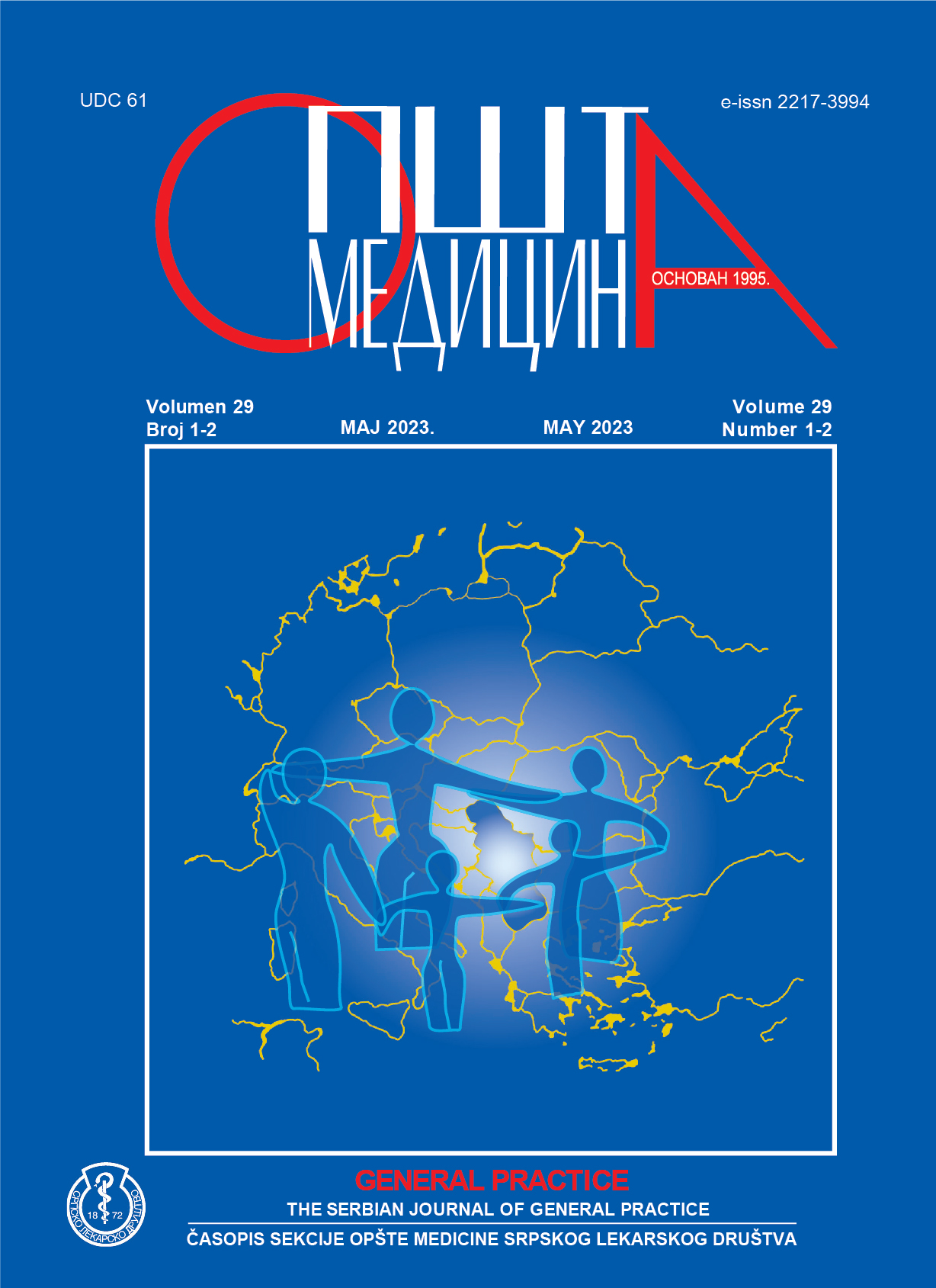Risk assessment for type 2 diabetes mellitus in the municipality of Golubac
Abstract
Introduction. There are approximately 17.000 new
cases of diabetes mellitus type 2 (DM2) in Serbia each year.
A third of the newly diagnosed already has some late disease
complications and almost half of them are over 65.
Objective. We aimed at determining the level and risk
factors for DM2 in respondents of different gender, age, and
lifestyle in the Municipality of Golubac.
Method. The study was conducted using the DM2
questionnaire. The sample had 404 participants who were
screened in the Municipality of Golubac. Significant statistical
methods were used in the study: frequency, t-test, ANOVA
test, and correlation analysis.
Results. The study showed the majority of participants
(40.1%) had slightly elevated risk for DM2, high risk was
found in 14.9%, and very high risk in 3.2%. Moderate risk
was found in 27.5% of the participants and 14.4% had low
risk. Women had a higher percentage of high and very high
risk for DM2 than men but no statistically significant difference
was found between men and women concerning the risk
of developing the disease. With age, as well as obesity, the
risk for DM2 increases. The participants who practiced regular
physical activity, as well as those who regularly consumed
fruits and vegetables, had a lower risk for DM2.
Conclusion. The study showed almost every fifth participant
had a high or very high risk for DM2, 81.7% were
overweight, and 75% had previously diagnosed cardiovascular
problems. Registration of persons with an elevated risk for
DM2 and further follow-up is a very important task for GPs
(general practitioners).
Keywords: diabetes, screening, risk factors, obesity
References
1. Institut za javno zdravlje “Dr Milan
Jovanović Batut”. Incidencija i mortalitet
od dijabetesa u Srbiji. Beograd: Institut
za javno zdravlje “Dr Milan Jovanović
Batut”, 2020.
2. Sicree R, Shaw JE, Zimmet PZ. The
Global Burden of diabetes. In: Gan D,
editor. Diabetes Atlas. 9th ed. Brussels:
International Diabetes Federation; 2019.
3. Ford ES. Risks for all-cause mortality,
cardiovascular disease, and diabetes
associated with the metabolic syndrome:
a summary of the evidence. Diabetes Care
2005;28(7):1769–78.
4. Beljić Živković T. Terapijski priručnik
za dijabetes tip 2. Beograd: Univerzitet u
Beogradu, Medicinski fakultet, 2018.
5. Finnish Diabetes Association. Type
2 diabetes risk assessment form.
Dostupno na: www.diabetes.fi/files/502/
eRiskitestilomake.pdf [Pristupljeno 2022]
6. America Diabetes Association. Are you
at risk for type 2 diabetes? http://main.
/>diabetes.org/dorg/PDFs/risk-test-paperversion.
pdf [Pristupljeno 2022]
7. Ministarstvo zdravlja. Nacionalni vodič
dobre kliničke prakse. Dijabetes melitus.
Beograd: Ministarstvo zdravlja, 2013.
8. Živanović D, Šipetić S, Stamenković-
Radak M, Milašin J. Potencijalni faktori
rizika za nastajanje dijabetesa melitusa
tipa 2. Med Pregl 2010;63(3-4):231–6.
9. Cifkova R, Pitha J, Krajcoviechova A,
Kralikova E. Is the impact of conventional
risk factors the same in men and women?
Plea for a more gender-specific approach.
Int J Cardiol 2019;286:214–9.
10. Kautzky-Willer A, Harreiter J, Abrahamian
H, Weitgasser R, Fasching P, Hoppichler
F, et al. Sex and gender-specific aspects in
prediabetes and diabetes mellitus-clinical
recommendations (Update 2019). Wien
Klin Wochenschr 2019;131(Suppl 1):
221–8.
11. Ćirić D, Jelenković B, Mitrović D,
Stanojlović O. Upitnik procene rizika
za tip 2 dijabetesa u praksi. Timočki
Medicinski Glasnik 2017;42(3):147–54.
12. McEwan P, Williams JE, Griffiths JD,
Bagust A, Peters JR, Hopkinson P,
et al. Evaluating the performance of
the Framingham risk equations in a
population with diabetes. Diabet Med
2004;21(4):318–23.
13. National Cancer Institute Surveillance,
Epidemiology, and End Results Program
[homepage on the Internet]. Cancer Stat
Facts: Leukemia - Acute Lymphocytic
Leukemia (ALL). Available from: https://
seer.cancer.gov/statfacts/html/alyl.html.
Accessed 2013
14. Tornese G, Ceconi V, Monasta L, Carletti
C, Faleschini E, Barbi E. Glycemic
control in type 1 diabetes mellitus during
COVID-19 quarantine and the role of inhome
physical activity. Diabetes Technol
Ther 2020;22(6):462–7.
15. Carbone S, Del Buono MG, Ozemek C,
Lavie CJ. Obesity, risk of diabetes and role
of physical activity, exercise training and
cardiorespiratory fitness. Prog Cardiovasc
Dis 2019;62(4):327–33.
16. Mihai VC, Remus PA. Risk Factors
for Diabetes Type 2 Development.
Comparison of 6 Major Risk Factors
Prevalence Between Newly Diagnosed
Diabetes Patients from Bihor County
and the Population with Normal Glucose
Tolerance from Predatorr Study. Internal
Medicine 2018; 15(3):33–8.
Autori zadržavaju autorska prava nad objavljenim člancima, a izdavaču daju neekskluzivno pravo da članak objavi, da u slučaju daljeg korišćenja članka bude naveden kao njegov prvi izdavač, kao i da distribuira članak u svim oblicima i medijima.

